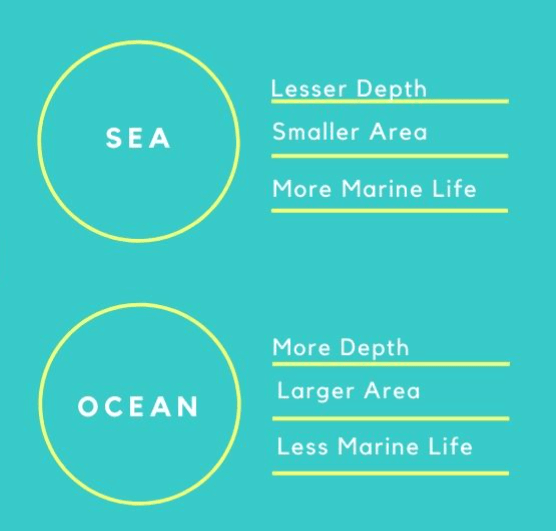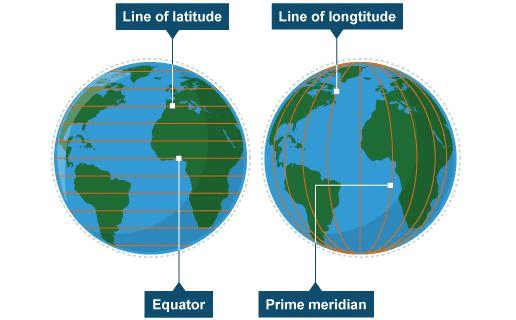The Earth-Our World Class 5 Notes SST
| Table of contents |

|
| Our Earth in the Solar System |

|
| The Shape of Our Earth |

|
| Continents of Earth |

|
| Water Bodies on Earth |

|
| What is a Globe? |

|
| Features of Earth as Studied through the Globe |

|
Our Earth in the Solar System
- Imagine you are an astronaut, looking down at Earth from space. What do you see? A beautiful blue and green ball floating in the vast, dark sky! This is our home, the only known planet where life exists.
From the snowy mountains to deep oceans, Earth is full of amazing places waiting to be explored.
- When man first landed on the moon (July 19, 1969), the Earth was seen as a shining spherical ball, the way we see other stars in the sky!
 Earth as seen from the moon
Earth as seen from the moon
- Let’s dive into this chapter and learn more about the incredible planet we call home!
The Shape of Our Earth
- Ordinarily, the Earth appears flat to us. That is so because we can, at any point in time, see only a very small part of it.
- But if you see it from afar, it is round!
- It should, however, be remembered that our Earth is not exactly like a sphere. More like an orange, it is flat at the poles.
- We live on the outer layer of the Earth called the Crust. The Earth’s surface is made up of land and water.
 The shape of our Earth is not round but it is like an Orange: Flat at Poles.
The shape of our Earth is not round but it is like an Orange: Flat at Poles.
Continents of Earth
The Earth comprises continents (big pieces of land) and water bodies (like oceans, seas, rivers, and lakes). Together, they make Earth look so colourful and lively!
The land is where people, animals, and plants live, and the water gives us life.
- There are seven main land masses known as continents. Asia is the largest of all the continents.
 Seven Continents of Earth
Seven Continents of Earth
- India is located on the continent of Asia.
- Each continent is divided into smaller parts called countries.
- Antarctica is a continent that has no permanent residents, only visiting scientists.
- Asia and Europe are separated by the Ural Mountains. Australia is unique as it is the only continent made up entirely of islands.
- North America and South America are connected by Central America, which is the southern part of North America.
- The continent of Africa was once referred to as the Dark Continent because, for a long time, most of the world knew very little about the insides of this continent.
Water Bodies on Earth
- There are large masses of water on Earth called oceans. One of them is named after the Indian subcontinent, which is the Indian Ocean.

- The other oceans are the Pacific, Atlantic, Arctic, and Southern (Antarctic) Oceans.
- Smaller bodies of water are called seas. Seawater is salty.
- There are lakes and rivers whose water is fit for drinking.
 Difference Between Sea and Oceans
Difference Between Sea and Oceans
What is a Globe?
A globe is a small, round model of the Earth. It shows the land, water, and different countries just like they are on our real planet. It helps us learn where places are in the world.
- If we have to travel to the west coast of North America, we may cross the Pacific Ocean or the Atlantic Ocean. Which would be the shorter route? A look at the globe can provide an easy answer.
 A Globe
A Globe
- The globe is shaped like a sphere.
- It has an axis that goes through its two ends, which are the North Pole and the South Pole.
- The globe can rotate around this axis.
- This axis is not perfectly vertical; instead, it is set on a horizontal base at a certain angle.
- The distribution of land and water on the surface of the Earth can be easily seen on the globe.
- Similarly, we can have a good idea of the relative sizes of the various continents by looking at the globe.
Features of Earth as Studied through the Globe
The globe helps us understand our home, the Earth, better. Let's have a look at some of the features of Earth we can see on the globe.
1. The Equator
The Equator is an imaginary line that goes around the middle of the Earth, like a belt.
It divides the Earth into two equal halves:
- Northern Hemisphere (top half)
- Southern Hemisphere (bottom half)

2. Latitudes
Latitudes are like invisible lines that wrap around the Earth, running horizontally from left to right. These lines help us divide the Earth into smaller sections and find places on a map or globe.
 Latitudes and Longitudes of Earth
Latitudes and Longitudes of Earth
- The size of the circles made by the latitudes decreases as you move away from the equator.
- These latitudes are labelled as North or South, depending on their location relative to the equator.
- The Tropic of Capricorn is located 23.5° South of the equator.
- Latitudes are measured from 0° at the equator to 90° at the poles.
- The equator itself is at 0° latitude, while the North and South poles are at 90° N and 90° S, respectively.
- The latitude at 23.5° N is named the Tropic of Cancer. The latitude at 23.5° S is referred to as the Tropic of Capricorn.
- The Tropic of Cancer passes through India.
- Two additional important latitudes are the Arctic Circle at 66.5° N and the Antarctic Circle at 66.5° S.

3. Longitudes
- The curved lines that connect the poles are known as Longitudes or Meridians.
- The line called the Prime Meridian runs through the Greenwich Observatory, which is located near London, England.
- Longitudes are numbered from 0° to 180° East and 0° to 180° West.
- The size of the latitudes changes, while all longitudes are the same length.
- These lines are all imaginary and are drawn on the globe. If you go to Greenwich, you will not find any physical line marked on the ground.
- The latitudes and longitudes create a grid on the surface of the globe.
4. Grids
- The squares thus formed by intersecting Longitude and Latitude lines are called ‘grid’.
 Grid Lines of Globe
Grid Lines of Globe - Knowing the latitude and longitude of a specific location allows us to find it on a globe easily.
- For example, Pondicherry, located in India, is positioned close to 12° N latitude and 80° E longitude, making it easy to identify on a globe. Bhopal, in Madhya Pradesh, is near the Tropic of Cancer for latitude and 78° E for longitude.
- The peak of K2, which rises to a height of 8611 meters, is found around 36° N latitude, within the range of 34° to 36° N latitude and 76° to 78° E longitude.
- These imaginary lines on the globe aid in understanding the geography and populations of different areas.
- The position of a place according to its meridian helps determine the local time.
- Latitudes have an impact on the different climates found around the world.

|
33 videos|423 docs|50 tests
|
FAQs on The Earth-Our World Class 5 Notes SST
| 1. What is the shape of the Earth? |  |
| 2. How many continents are there on Earth? |  |
| 3. What are the major water bodies on Earth? |  |
| 4. What is a globe and how is it useful? |  |
| 5. What features of Earth can we study using a globe? |  |





















